Contents
- Crop Cultivation
- Agricultural Communities
- Pioneering Women Agriculturalists
- Festivals/Rituals Related to Farming
- Types of Farming
- Shifting agriculture
- Pearl Farming
- Traditional Agricultural Practices
- Use of Technology
- ATMA, Gadchiroli Initiative
- Institutional Infrastructure
- Watershed Program
- Medigadda Dam
- Market Structure: APMCs
- List of APMC markets(as of September 2024)
- Farmers Issues
- Infrastructure issues
- Naxalite Movement
- Mining
- Climate Change: Its Effects on Agriculture
- Graphs
- Irrigation
- A. No. of Projects
- B. No. of Ponds/Vilage Lakes and Storage Dams
- C. Irrigation Beneficiary Area vs Irrigated Area
- D. Share of Beneficiary Area Irrigated
- E. Tubewells and Pumps Installed In The Year
- F. Irrigation and Water Pumping Facilities
- Cropping Metrics
- A. Share in Total Holdings
- B. Cultivated Area (With Components)
- C. Gross Cropped Area (Irrigated + Unirrigated)
- D. Share of Cropped Area Irrigated
- E. Distribution of Chemical Fertilizers
- Land Use and Credit
- A. Area of Agricultural Land Holdings (With Size Group)
- B. Size Groups' Share in Total Agricultural Land Holdings Area
- C. No. of Agricultural Land Holdings (With Size Group)
- D. Size Groups' Share in Total No. of Agricultural Land Holdings
- E. Agricultural Lending
- F. Agricultural Credit as a share of Total Credit
- Sources
GADCHIROLI
Agriculture
Last updated on 6 November 2025. Help us improve the information on this page by clicking on suggest edits or writing to us.
Gadchiroli district is located in the drought-prone Vidarbha region of Maharashtra (the district was carved out of the larger Chandrapur district in 1982), in the Eastern plateau and hills region. Known for its rich black soil, typical of the Deccan Plateau, the district’s economy is primarily agricultural, with Paddy and Pigeon Pea (Tur Dal) as the major crops.
Crop Cultivation
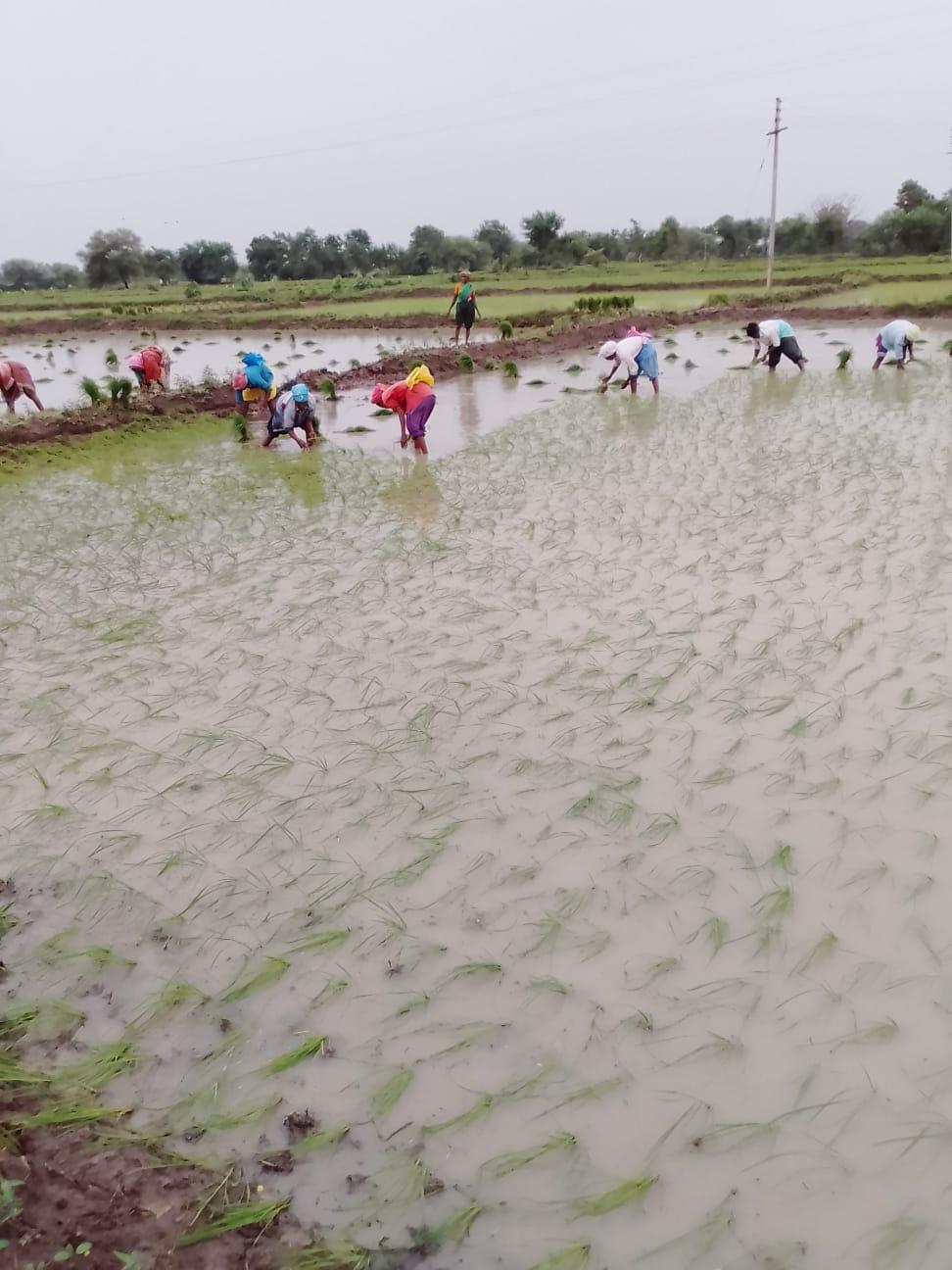
The district of Gadchiroli is situated entirely in the eastern part of the Deccan Plateau. The climate is generally hot and sub-humid, with temperatures and humidity levels varying by season. The main soil types found in the region include deep black soils, medium deep black soils, and shallow black soils, which influence the cropping patterns and productivity in different parts of the district. Notably, Gadchiroli is also known for its deposits of mineral resources, including iron ore and limestone, which support local mining activities.

The district is traversed by several important rivers, such as the Wainganga, Godavari, Pranhita, Dina, Indravati, Gadhavi, Khobragadi, Pal Welochanna, Kathani, Siwani, Por, and Darshani. These rivers contribute to the region’s agricultural potential by supporting irrigation and providing water for domestic and industrial use.
Agriculture in Gadchiroli mainly includes Kharif crops, which are sown during the monsoon season. The main Kharif crops grown are paddy, pigeon pea (tur), soybean, maize, and sorghum. During the Rabi season, which follows the monsoon, farmers cultivate crops such as wheat, gram, Rabi sorghum, and linseed.
In addition to field crops, horticulture also plays a role in the local economy. Farmers grow fruits and vegetables such as mangoes, cashew nuts, chickoos (sapota), chillies, turmeric, onions, brinjals (eggplant), and tomatoes. In recent years, safflower (kardai) cultivation has also seen a revival in parts of the district, adding to the diversity of crops grown here.
Agricultural Communities
Several communities in Gadchiroli and the surrounding region have long been associated with agriculture. Among them, the Kunbis are the largest cultivator group, so much so that the term Kunbi is commonly used to refer to farmers in general. The community includes various sub-groups such as the Tirole, Khaire, Dhanoje, Khedula, Jharia, and Wandhekar. They mainly grow crops like jowar and oilseeds and maintain quality cattle. The Khaire Kunbis, in particular, are known for rice and jowar cultivation and for their traditional skill in building water tanks.
The Marar or Malis tend small irrigated garden plots, supplying vegetables and spices across the district. Some sub-groups specialise in flowers, garlic, brinjal, turmeric, and other crops. The Mahars often work as agricultural labourers, though some own farmland. The Kapewars and Velamas are both Telugu-speaking cultivator groups who have combined farming with other traditional occupations such as masonry, military service, dyeing, and weaving.
Among indigenous communities, the Gonds have historically been the largest, divided into sub-groups like the Raj-Gonds and Madias, who often rely on forest resources alongside cultivation. The Pardhans, traditionally village service providers to the Gonds, have increasingly turned to farming. The Kolis are noted for their expertise in irrigation works and are important growers of rice and sugarcane, producing much of the region’s gur (jaggery). Other forest-based groups such as the Kavars, Halbis, Thotis, and Jharias also contribute to local agriculture, mainly as small farmers or labourers.
Pioneering Women Agriculturalists
Women play an important role in agriculture across Gadchiroli, with many contributing significantly through innovative farming practices and careful crop management.
Among them, Deepali Khune, a farmer from Visora village in Desaiganj taluka, has gained recognition for her innovative farming practices. Holding a B.Sc. in Agriculture, she has experimented with innovative farming methods to diversify her crops and maximise income from her land. On her one-and-a-half-acre plot, she cultivates a variety of vegetable crops throughout the year while balancing her household responsibilities alongside her husband.
Between March and May 2023, Deepali grew tomatoes and earned approximately ₹3.5 lakh. From June to August 2023, she cultivated curry and cowpea crops, generating another ₹2 lakh. Later, from December 2023 to March 2024, she harvested watermelons, adding another ₹3.5 lakh to her income. Altogether, she earned around ₹9 lakh in a single year from her small farm, demonstrating how innovative approaches and careful crop planning can yield significant returns even on limited land.
Festivals/Rituals Related to Farming
Dances of the indigenous communities in India have deep roots in spiritual traditions, often viewed as a means of connecting with the divine. These dances are intricately linked to religious beliefs, with various rituals performed through movement and music. They play a significant role in social functions, ceremonies, and activities such as hunting and agriculture, allowing communities to express their joy and celebrate life.
In Gadchiroli, the indigenous communities typically engage in lively singing and dancing on Sugi, which marks the beginning of harvest season.
Types of Farming
Shifting agriculture
In Bhamragad taluka, many people practice shifting agriculture, also known as Jhum cultivation. This area is primarily inhabited by the Madia Gonds, who continue this traditional method of farming. In Jhum cultivation, a portion of the forest is cleared and burned, and the land is used for cultivation for a few years. Afterward, the plot is left fallow to allow the forest to naturally reclaim it, while the cultivators move to a new area to repeat the process.
Pearl Farming
Among the various types of farming practised in Gadchiroli, pearl farming has recently emerged as an alternative source of income for some farmers. Sanjay Gandate from Pardi Kupi village is one of the district’s few pearl cultivators. Coming from a family that has traditionally grown rice on their three-acre farm near the Wainganga River, he developed an early interest in the shells and oysters found along the riverbanks.
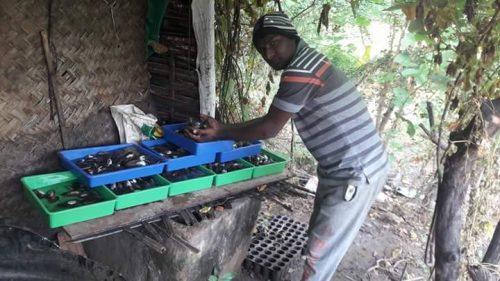
His experiments with freshwater oysters began in 2000, while he was still a student. After studying how oysters form pearls in response to irritants, he gradually developed methods for mantle grafting and nucleus implantation. Despite facing major setbacks, including the destruction and theft of oysters, he continued to refine his techniques. By setting up a freshwater tank at his home in 2015, he was able to successfully cultivate about 5,000 pearls by late 2016.
Since then, Sanjay Gandate’s pearl farming venture has earned him an income of about ₹10–12 lakh. With a low initial investment, the method depends mainly on careful maintenance and patience. He also enhanced his skills with training from the Krishi Vigyan Kendra. Although still uncommon in Gadchiroli, pearl farming shows potential as an additional livelihood option alongside conventional agriculture.
Traditional Agricultural Practices
In parts of Gadchiroli, traditional farming methods continue to be practiced alongside modern techniques. One such method is Penda cultivation, a form of shifting cultivation historically used by various indigenous communities. Although this practice has declined significantly due to large areas of forest being designated as protected zones, some communities still prefer it, viewing it as more sustainable than modern intensive methods. Many families have gradually adopted settled farming and modern tools, moving away from a shifting lifestyle.
In addition to cultivation, indigenous communities often gather Ranbhajis (wild vegetables) from the dense forests, supplementing their food supply and preserving traditional knowledge of local biodiversity. Some farmers also continue to grow native paddy varieties such as Luchai, Bikhadboli, Kolari, and Kakeri, which are well suited to local conditions.

Use of Technology
ATMA, Gadchiroli Initiative
Efforts have been made to introduce improved practices and technology to farming communities in Gadchiroli. In 2018, the Krishi Vigyan Kendra (KVK), in collaboration with the Agricultural Technology Management Agency (ATMA), the Department of Agriculture, and the Department of Animal Husbandry, organised an agricultural welfare campaign in Temba village. The campaign promoted integrated farming by encouraging farmers to adopt allied activities such as poultry rearing, horticulture, and dairy production. Training was also provided on using modern technologies and resources to increase productivity and diversify incomes.

Institutional Infrastructure
Despite its agricultural potential, it appears that Gadchiroli’s farming infrastructure remains limited. According to the NABARD report (2023-24), the district has five Agricultural Produce Market Committees (APMCs), 114 godowns for storage, but no dedicated cold storage facilities. There are three soil testing centres, five plantation nurseries, 122 farmers’ clubs, and approximately 1,700 outlets supplying fertilisers, seeds, and pesticides. One Krishi Vigyan Kendra operates in the district, providing agricultural extension services and training to farmers.
Watershed Program
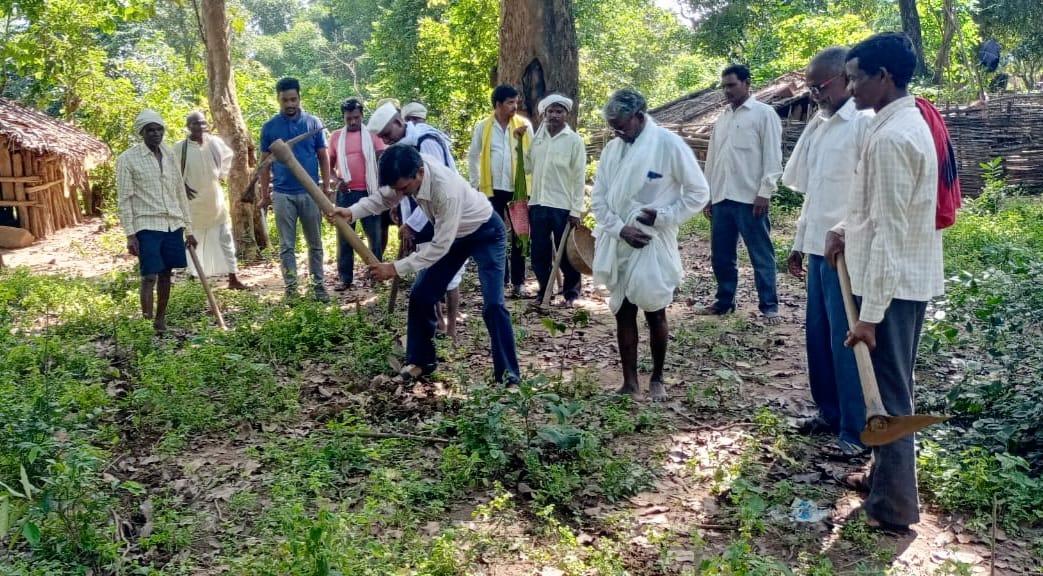
The Watershed Organisation Trust (WOTR) launched an integrated watershed development initiative in 35 villages of Gadchiroli’s Dhanora taluka in October 2022. The project focuses on water conservation, agricultural development, and promoting sustainable livelihoods for the local, largely indigenous population. Activities include lake desiltation, construction of new lakes, biodiversity enhancement, and agricultural training. The initiative is part of the Government of India’s Aspirational Districts Programme and aims to build climate resilience and improve living conditions for vulnerable communities. The project also aims to transform the lives of the communities of the Gadchiroli district.
Medigadda Dam

Medigadda, also known as Lakshmi Barrage, is a concrete dam located on the Maharashtra-Telangana border in Telangana. Constructed on the Godavari River, which flows through the Sironcha taluka of Gadchiroli district. The dam's construction was completed in 2019, with a total length of 1.632 km. While it plays a crucial role in water management, the Medigatta project has harmed the people of Sironcha taluka. Each year during the rainy season, the dam's backwaters cause flooding, damaging thousands of hectares of agricultural land and resulting in significant agricultural losses. Medigadda Barrage remains a key infrastructure project in Telangana.
Market Structure: APMCs
There are APMCs at Aheri, Armori, Chamorshi, Gadchiroli, and Sironcha. Among these, the APMC at Gokul Nagar, Gadchiroli city, is the oldest. It was established in 1960. Farm produce such as Paddy-unhusked, gram, Pigeon pea, Black gram, Linseed, soybean, etc., are important commodities that are sold at these markets.

List of APMC markets(as of September 2024)
|
Sr. No |
Name |
Est. Year |
Chairman |
No. of Godowns |
|
1 |
Aheri |
1979 |
Ravindrababa Atram |
5 |
|
2 |
Armori |
1961 |
Ishwar Dharmaji Pasewar |
7 |
|
3 |
Chamorshi |
1999 |
Premanand Viswnath Mallik |
10 |
|
4 |
Gadchiroli |
1960 |
Shashikant Salave |
5 |
|
5 |
Sironcha |
NA |
NA |
NA |
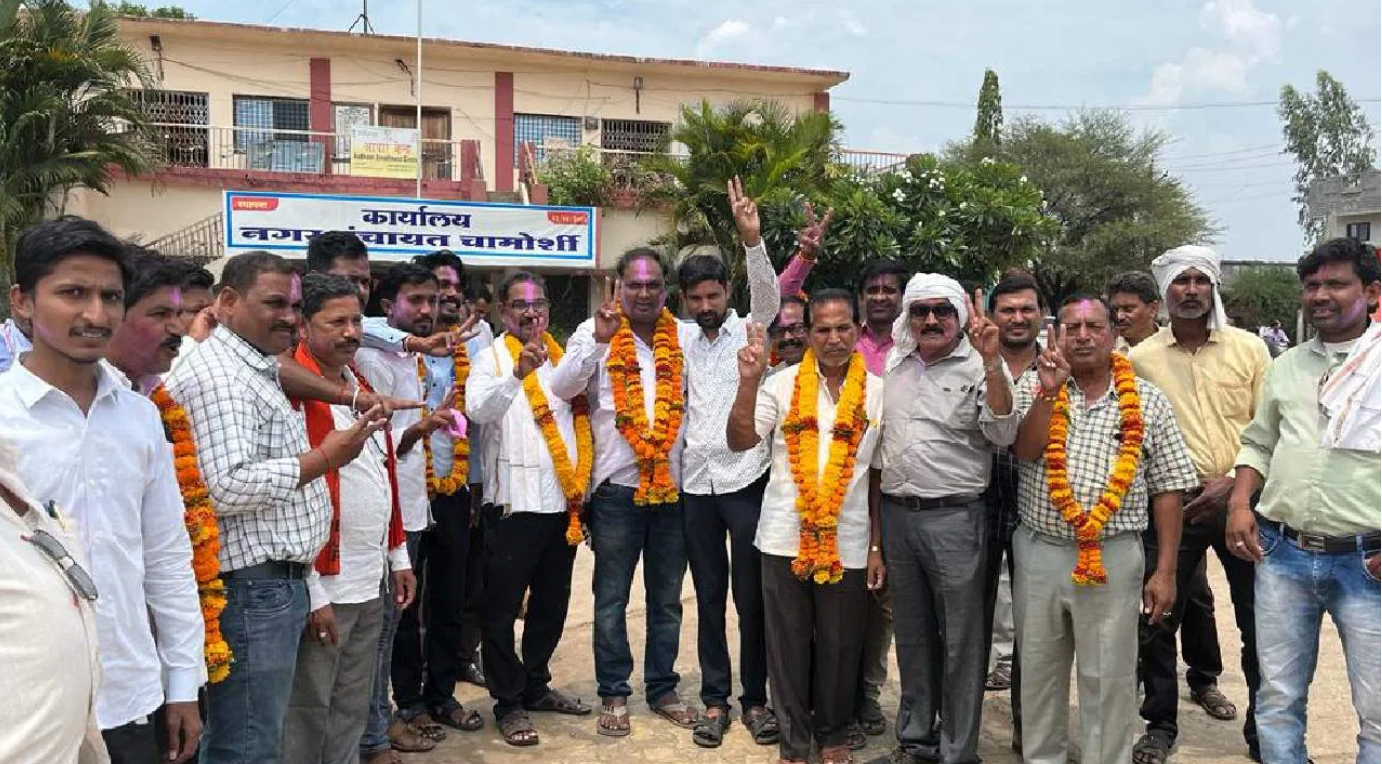
Farmers Issues
Infrastructure issues
Gadchiroli district is characterised by extensive forest cover, with 76% of its total area classified as forest land, including India’s largest stretch of “very dense” forest, covering about 4,706 sq. km. The terrain is largely hilly and uneven, even in its plains, which makes the development of basic infrastructure particularly challenging. The district has around 9,184 km of pucca roads, and out of its many villages, about 1,509 have access to electricity. However, only 455 villages receive power specifically for agricultural use, and 1,186 are connected by all-weather roads, underlining the limited reach of transport and energy infrastructure for farming communities.
Naxalite Movement
Since the early 2000s, Gadchiroli has witnessed persistent Naxalite activity. The movement, active in several districts of Maharashtra such as Gondia, Chandrapur, Bhandara, Nanded, and Yavatmal, is partly driven by spillover effects from neighbouring states like Chhattisgarh, Madhya Pradesh, and Telangana. Weak governance, corruption, and dissatisfaction among indigenous communities have contributed to its spread. The ongoing conflict creates security risks that can delay or disrupt rural infrastructure works and development activities, further limiting support and services available to farming communities.
Mining
Mining activities have also had a significant impact on local agriculture and village life. In areas such as Damkondawahi and Surjagarh, iron ore extraction has affected communities mainly belonging to the Madia group, classified as a Particularly Vulnerable Tribal Group (PVTG). Mining operations have led to contamination of local water sources, turning them red and unsafe for consumption, while mining debris has damaged cultivable land. Villagers have long resisted these projects, citing pollution from red iron oxide and other chemical discharges, which have negatively affected farming, local health, and overall living conditions.
Climate Change: Its Effects on Agriculture
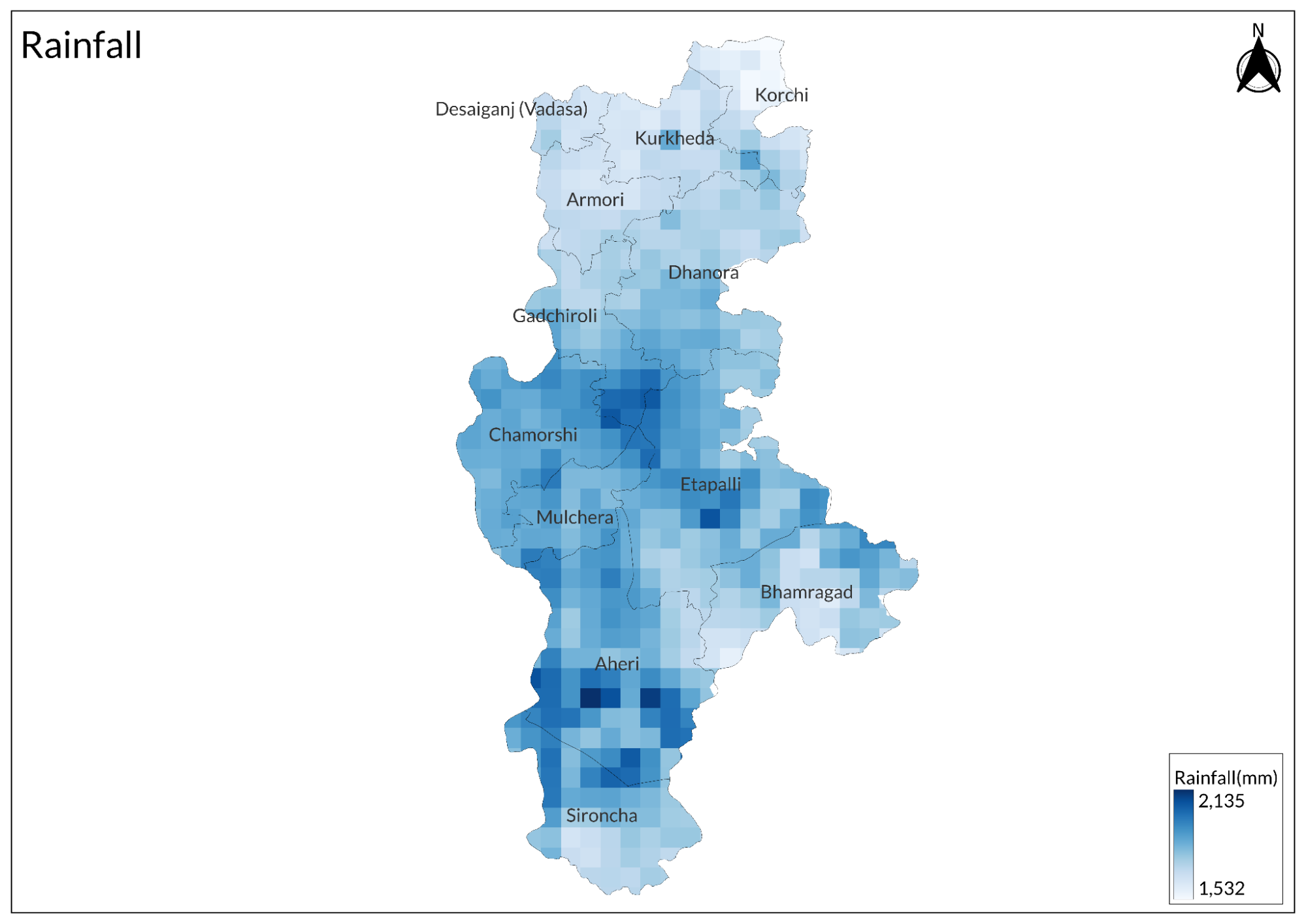
Gadchiroli lies in a drought-prone zone and has a long history of experiencing famines, including major events in 1832, 1868–69, 1892–95, 1900, 1957–58, 1959–60, 1965–66, and more recently in 2014 and 2019. Over the past decade (2013–2023), the district saw insufficient rainfall in 2014, followed by above-average rainfall between 2016 and 2019. In 2013, the broader Vidarbha region, which includes Gadchiroli, was severely affected by floods that damaged about 7,00,000 hectares of farmland and caused significant loss of life. Such recurring droughts, floods, and unpredictable weather patterns make agriculture in the district increasingly uncertain and risky for local farmers.
Graphs
Irrigation
Cropping Metrics
Land Use and Credit
Sources
Forest Survey of India. Forest Survey of India 2017. Ministry of Environment & Forests.
ICAR. MAHARASHTRA Agriculture Contingency Plan for District: GADCHIROLI. ICAR - CRIDA - NICRA.
Katoch, Manabi. 2017. "How Pearl Farming Helped This Farmer Grow Rich!" The Better India.https://thebetterindia.com/89574/sanjay-gand…
Lokmat. 2021. "Success Story of Farmer Woman with B.Sc Agri in Gadchiroli District." Lokmat.https://www.lokmat.com/agriculture/success-s…
Maharashtra State Gazetteers. 1972. Chandrapur District. Government of Maharashtra.
NABARD. 2023-24. Potential Linked Credit Plan: Gadchiroli.Maharashtra Regional Office, Pune.
Pallavi, Aparna. 2014. "How Central Indian Tribes Cope with Climate Change Impacts." Down To Earth.https://www.downtoearth.org.in/environment/h…
The Hitavada. 2021. "East Vid Farmers Opting for Safflower Cultivation." The Hitavada.https://www.thehitavada.com/Encyc/2021/3/3/E…
Last updated on 6 November 2025. Help us improve the information on this page by clicking on suggest edits or writing to us.